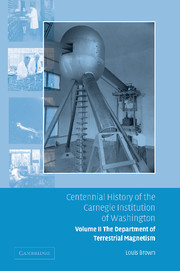Book contents
- Frontmatter
- Contents
- Foreword by Richard A. Meserve
- Preface
- 1 Establishment
- 2 Cruises and war
- 3 Expeditions
- 4 Measurements: magnetic and electric
- 5 The Fleming transition
- 6 The last cruise
- 7 The magnetic observatories and final land observations
- 8 The ionosphere
- 9 Collaboration and evaluation
- 10 The Tesla coil
- 11 The Van de Graaff accelerator
- 12 The nuclear force
- 13 Fission
- 14 Cosmic rays
- 15 The proximity fuze and the war effort
- 16 The Tuve transition
- 17 Postwar nuclear physics
- 18 The cyclotron
- 19 Biophysics
- 20 Explosion seismology
- 21 Isotope geology
- 22 Radio astronomy
- 23 Image tubes
- 24 Computers
- 25 Earthquake seismology
- 26 Strainmeters
- 27 The Bolton and Wetherill years
- 28 Astronomy
- 29 The solar system
- 30 Geochemistry
- 31 Island-arc volcanoes
- 32 Seismology revisited
- 33 Geochemistry and cosmochemistry
- 34 The Solomon transition
- 35 The support staff
- 36 Epilogue
- Notes
- Index
22 - Radio astronomy
Published online by Cambridge University Press: 06 January 2010
- Frontmatter
- Contents
- Foreword by Richard A. Meserve
- Preface
- 1 Establishment
- 2 Cruises and war
- 3 Expeditions
- 4 Measurements: magnetic and electric
- 5 The Fleming transition
- 6 The last cruise
- 7 The magnetic observatories and final land observations
- 8 The ionosphere
- 9 Collaboration and evaluation
- 10 The Tesla coil
- 11 The Van de Graaff accelerator
- 12 The nuclear force
- 13 Fission
- 14 Cosmic rays
- 15 The proximity fuze and the war effort
- 16 The Tuve transition
- 17 Postwar nuclear physics
- 18 The cyclotron
- 19 Biophysics
- 20 Explosion seismology
- 21 Isotope geology
- 22 Radio astronomy
- 23 Image tubes
- 24 Computers
- 25 Earthquake seismology
- 26 Strainmeters
- 27 The Bolton and Wetherill years
- 28 Astronomy
- 29 The solar system
- 30 Geochemistry
- 31 Island-arc volcanoes
- 32 Seismology revisited
- 33 Geochemistry and cosmochemistry
- 34 The Solomon transition
- 35 The support staff
- 36 Epilogue
- Notes
- Index
Summary
In 1936 Karl Jansky was studying the noise in a 20 MHz radio receiver at the Bell Telephone Laboratories and observed a source that could not be ascribed to the amplifier, atmospheric discharges or man-made interference. He then constructed a directional antenna that could be rotated about its vertical axis and after a long series of observations showed the noise to be extraterrestrial and to come from the constellation Sagittarius. Astronomers were perplexed as to what to do with this, and no one continued such study except Grote Reber, a radio amateur, who was able to have his sky survey published in the Astrophysical Journal in 1944.
During the war radar engineers working with steerable meter-wave equipment encountered Jansky's “cosmic noise” among other sources. The paths of meteors entering the atmosphere left ion trails that could be tracked by radar, and Bernard Lovell used radar signals reflected from them to show that the meteors were from the solar system, a question open since the days of Newton. The radar engineers also rediscovered strong radio emissions from the Sun during sunspot activity, something observed before the war by amateurs whose work was not appreciated by the learned. Dutch astronomers, inspired by Reber's article, pointed out the theoretical possibility of observing a hyper-fine transition from atomic hydrogen in space and saw their predictions verified after the end of hostilities.
Given the Department's interest in radio studies of the ionosphere, it is rather surprising that Tuve did not enter the field until 1952.
- Type
- Chapter
- Information
- Centennial History of the Carnegie Institution of Washington , pp. 163 - 174Publisher: Cambridge University PressPrint publication year: 2005



